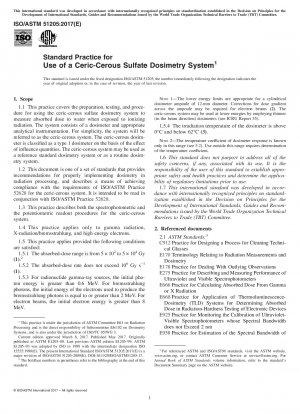ASTM ISO/ASTM 51205-17
Standard Practice for Use of a Ceric-Cerous Sulfate Dosimetry System
- Standard No.
- ASTM ISO/ASTM 51205-17
- Release Date
- 2016
- Published By
- American Society for Testing and Materials (ASTM)
- Latest
- ASTM ISO/ASTM 51205-17
- Scope
- 1.1 This practice covers the preparation, testing, and procedure for using the ceric-cerous sulfate dosimetry system to measure absorbed dose to water when exposed to ionizing radiation. The system consists of a dosimeter and appropriate analytical instrumentation. For simplicity, the system will be referred to as the ceric-cerous system. The ceric-cerous dosimeter is classified as a type 1 dosimeter on the basis of the effect of influence quantities. The ceric-cerous system may be used as a reference standard dosimetry system or as a routine dosimetry system. 1.2 This document is one of a set of standards that provides recommendations for properly implementing dosimetry in radiation processing, and describes a means of achieving compliance with the requirements of ISO/ASTM Practice 52628 for the ceric-cerous system. It is intended to be read in conjunction with ISO/ASTM Practice 52628. 1.3 This practice describes both the spectrophotometric and the potentiometric readout procedures for the ceric-cerous system. 1.4 This practice applies only to gamma radiation, X-radiation/bremsstrahlung, and high energy electrons. 1.5 This practice applies provided the following conditions are satisfied: 1.5.1 The absorbed-dose range is from 5 × 102 to 5 × 104 Gy (1).2 1.5.2 The absorbed-dose rate does not exceed 106 Gy s−1 (1). 1.5.3 For radionuclide gamma-ray sources, the initial photon energy is greater than 0.6 MeV. For bremsstrahlung photons, the initial energy of the electrons used to produce the bremsstrahlung photons is equal to or greater than 2 MeV. For electron beams, the initial electron energy is greater than 8 MeV. NOTE 1—The lower energy limits are appropriate for a cylindrical dosimeter ampoule of 12-mm diameter. Corrections for dose gradient across the ampoule may be required for electron beams (2). The ceric-cerous system may be used at lower energies by employing thinner (in the beam direction) dosimeters (see ICRU Report 35). 1.5.4 The irradiation temperature of the dosimeter is above 0°C and below 62°C (3). NOTE 2—The temperature coefficient of dosimeter response is known only in this range (see 5.2). Use outside this range requires determination of the temperature coefficient. 1.6 This standard does not purport to address all of the safety concerns, if any, associated with its use. It is the responsibility of the user of this standard to establish appropriate safety and health practices and determine the applicability of regulatory limitations prior to use. 1.7 This international standard was developed in accordance with internationally recognized principles on standardization established in the Decision on Principles for the Development of International Standards, Guides and Recommendations issued by the World Trade Organization Technical Barriers to Trade (TBT) Committee.
ASTM ISO/ASTM 51205-17 history
- 2016 ASTM ISO/ASTM 51205-17 Standard Practice for Use of a Ceric-Cerous Sulfate Dosimetry System
- 2002 ASTM ISO/ASTM 51205-09 Standard Practice for Use of a Ceric-Cerous Sulfate Dosimetry System
